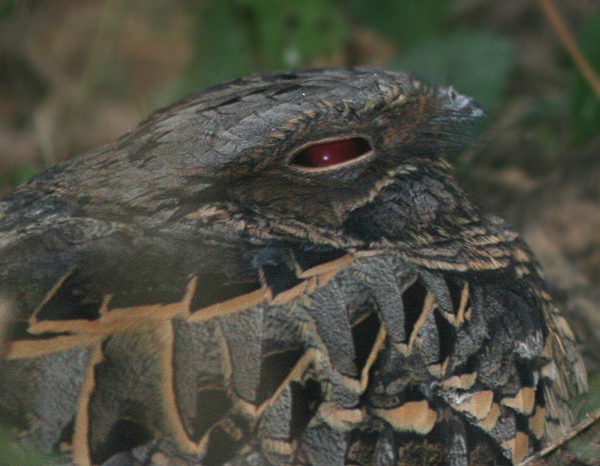The Common Pauraque (Nyctidromus albicollis) is a most garrulous goatsucker found in the warmer portions of the Americas. From Texas south to Argentina, pauraques populate fields, scrub, and essentially anywhere they may recline unmolested ere they rise for their twilight supper. My experience assures me that the only bird in the genus Nyctidromus isn’t all that difficult to find if you know its habits and habitat. Pronouncing the name of this nifty nightjar properly, on the other hand, seems to lay the most erudite avian enthusiasts low.
Pauraque is a peculiar name to be sure, but it derives from a Mexican transliteration of the bird’s call. Volume 65 (1948) of the Auk explains “The correct name for the Pauraque.”
The people called the bird “Parruaca” which, in accordance with Spanish rules of pronunciation generally, and local usage in particular, is pronounced, “Pahr-r-r-wah-kuh,” the “r” being rolled rather strongly, the accented syllable “wah” cut rather short, and the final syllable “kuh,” swallowed — that is, pronounced on an indrawn breath.
As the “pah” part of the first syllable is also pronounced rather shortly, or not voiced distinctly, the general effect when heard is of the trilled “r” and the accented “wah,” followed by a clean cut “kuh.” The result as absorbed by the ear is not unlike our word “squawk,” though softened by the preceding and following sounds.
So according to this source, pauraque is pronounced pahr-WAH-kuh. Yet, I heard four or five different pronunciations of the word and probably uttered about three new variations myself. So let’s alleviate some of the anxiety that comes when tackling a new name. How do you pronounce PAURAQUE?
Of course, you can try to avoid the ambiguity entirely by using the Mexican Spanish cuiejo or Belize kriol hooyu to identify this bird, but then you’d have to figure out how to pronounce them too…














Since the name is ultimately echoic, it should be pronounced PRRRREEEEeeeeerrrr.
I agree with Rick! But I voted for pow-ROCK-ay because I always pronounce it like a Spanish speaker with “pow” being closest to the way you would pronounce the dipthong “au” and “que” being pronounced “kay” or really more like “keh”. I guess we need to find out who determined the spelling and blame them. To match the historical pronunciation and have a Mexican spelling, you would need to spell it the way they had it “Parruaca.”
Sadly, I’m most unlikely to get the chance to exclaim, “Look! A pauraque!” so the exercise is academic for me. In any case, I’d probably opt for the more pronounceable, “Look! A Nyctidromus albicollis!”
Gringo that I am I have always thought it was pronounced paw-rake. Though, like pohanginapete, I have never acutally had reason to say pauraque out loud before.
If it’s anything like my Pauraque experiences, the argument is largely academic when you’re explaining to the third Border Patrol officer of the night just why you’re slowly driving up and down backroads near the Mexican border…
Yeh, as Patrick said, I don’t think the pronunciation of “Parruaca” has anything to do with the current English pronunciation of Pauraque. Apparently the transliteration was botched badly, so nothing in the current spelling hints at the older pronunciation. Attempting to maintain it would be absurd (though certainly not without precedent in the wretched but delightful English orthography).
pow-RAH-kay (and when speaking English I would simply use a retroflex approximant for the ‘r’ since apparently this is pseudo-Spanish anyway)
ANYway, this bird eluded me on my last trip to the Valley, but there’s always next time. 🙂
I’ve always thought it was paw-rack – now I’m really confused…
Whatever the pronunciation, that’s a wonderful piece of text there, Mike!
When I was touring the Rio Grande Valley, everybody there called it a “Puh-RACK.”
What about PAW-ruh-cue (like barbecue)? I’m going to start using that and see if it catches on. 🙂
I had always pronounced it puh-rock-eh (rolling the r just a little bit and swallowing the eh), until I went to Texas and heard others calling is a pa-ROCk-ee (hard r and long E at the end – which never sounded correct to my ear). From that point, I just assumed that somebody who lived near the birds knew better then me, and changed the way that I pronounced it, even though it seemed wrong.
This has encouraged me to go back to my initial pronounciation.
(And maybe I’ll through a few PAW-ruh-cues around to help Patrick in his new ‘research project’)
Good luck with that, Patrick. I’ll do what I can to help the cause.
I love that we have twice as many comments as votes. I should have dared people to come up with a pronunciation even if they’ve never come near a pauraque. I probably also should have included all these new variations.
And David, nice way to interject “retroflex approximant” into a what was a civilized dialogue!
I’ve always used (well dreamed of using) Parkay, followed by “butter”. (or did you get those ads down there?)
en puerto rico se conoce como el guebairo y esta en extinsion
hi daddy